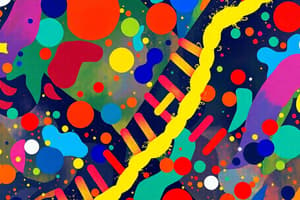Podcast
Questions and Answers
How is the genetic code expressed and what is its similarity among organisms?
How is the genetic code expressed and what is its similarity among organisms?
The genetic code can be expressed in a simple table with 64 entries. It is highly similar among all organisms.
What is the genetic code and how is it used by living cells?
What is the genetic code and how is it used by living cells?
The genetic code is the set of rules used by living cells to translate information encoded within genetic material (DNA or RNA sequences of nucleotide triplets, or codons) into proteins. Translation is accomplished by the ribosome, which links proteinogenic amino acids in an order specified by messenger RNA (mRNA), using transfer RNA (tRNA) molecules to carry amino acids and to read the mRNA three nucleotides at a time.
What do the codons specify in the genetic code and how do they function?
What do the codons specify in the genetic code and how do they function?
The codons specify which amino acid will be added next during protein biosynthesis. A three-nucleotide codon in a nucleic acid sequence specifies a single amino acid.
What is the canonical or standard genetic code and are there any variant codes?
What is the canonical or standard genetic code and are there any variant codes?
What is the role of the ribosome in translation and protein biosynthesis?
What is the role of the ribosome in translation and protein biosynthesis?
Who invented the polymerase chain reaction (PCR) and in what year?
Who invented the polymerase chain reaction (PCR) and in what year?
What is the significance of PCR in genetic testing and research?
What is the significance of PCR in genetic testing and research?
How are DNA sequences amplified using PCR?
How are DNA sequences amplified using PCR?
What are some of the applications of PCR in medical laboratory research?
What are some of the applications of PCR in medical laboratory research?
What is the role of Kary Mullis and Michael Smith in the development of PCR?
What is the role of Kary Mullis and Michael Smith in the development of PCR?
Explain the significance of the polymerase chain reaction (PCR) in genetic testing and research, and provide examples of its applications in these fields.
Explain the significance of the polymerase chain reaction (PCR) in genetic testing and research, and provide examples of its applications in these fields.
Describe the process of exponentially amplifying small amounts of DNA sequences using PCR.
Describe the process of exponentially amplifying small amounts of DNA sequences using PCR.
What is the role of PCR in medical laboratory research, and what are some of its applications in this field?
What is the role of PCR in medical laboratory research, and what are some of its applications in this field?
Discuss the contribution of Kary Mullis and Michael Smith to the development of the polymerase chain reaction (PCR).
Discuss the contribution of Kary Mullis and Michael Smith to the development of the polymerase chain reaction (PCR).
Explain the reliance of PCR methods on temperature changes and cycles, and its role in amplifying DNA sequences.
Explain the reliance of PCR methods on temperature changes and cycles, and its role in amplifying DNA sequences.
What is the role of PCR in biomedical research and criminal forensics?
What is the role of PCR in biomedical research and criminal forensics?
Who were jointly awarded the Nobel Prize in Chemistry in 1993 for their work related to PCR?
Who were jointly awarded the Nobel Prize in Chemistry in 1993 for their work related to PCR?
How are copies of very small amounts of DNA sequences amplified in PCR?
How are copies of very small amounts of DNA sequences amplified in PCR?
What is the significance of PCR in genetic testing and research?
What is the significance of PCR in genetic testing and research?
What is the majority of PCR methods reliant on?
What is the majority of PCR methods reliant on?
Flashcards are hidden until you start studying
Study Notes
Genetic Code and Expression
- The genetic code is used by living cells to translate DNA sequences into proteins.
- The code is expressed through codons, which specify the sequence of amino acids in a protein.
- Codons are triplets of nucleotides that function as a unit to code for one amino acid.
- The genetic code is similar across organisms, with some variations in the mitochondrial genetic code.
Standard Genetic Code and Variants
- The canonical or standard genetic code is the most common genetic code used by living cells.
- There are variant codes, such as the mitochondrial genetic code, which differ from the standard code.
Ribosome and Translation
- The ribosome plays a crucial role in translation, reading the mRNA sequence and assembling the corresponding amino acids into a protein.
- The ribosome is responsible for protein biosynthesis, linking amino acids together to form a polypeptide chain.
Polymerase Chain Reaction (PCR)
- PCR is a laboratory technique used to amplify small amounts of DNA sequences.
- The process involves exponential amplification of DNA sequences using temperature cycles and enzymatic reactions.
- Kary Mullis and Michael Smith were key contributors to the development of PCR.
- Mullis and Smith were jointly awarded the Nobel Prize in Chemistry in 1993 for their work related to PCR.
PCR Applications
- PCR is significant in genetic testing and research, allowing for the analysis of small DNA samples.
- Applications of PCR in medical laboratory research include genetic testing, disease diagnosis, and forensic analysis.
- PCR is also used in biomedical research and criminal forensics.
- The majority of PCR methods rely on temperature changes and cycles to amplify DNA sequences.
Studying That Suits You
Use AI to generate personalized quizzes and flashcards to suit your learning preferences.




